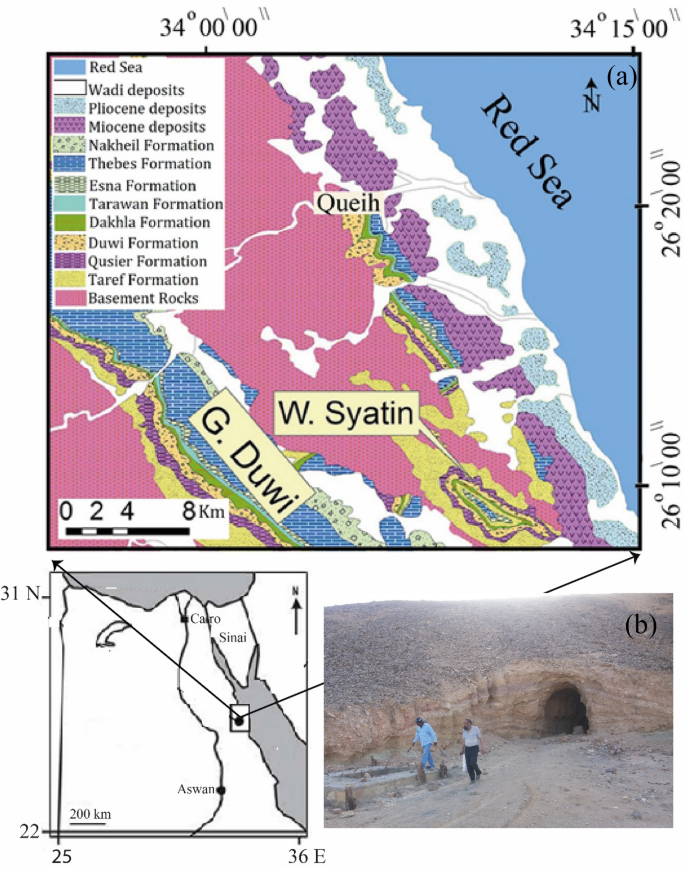埃及中东部沙漠Quseir Queih矿上白垩统白云岩磷酸盐地球化学和矿物学分析:沉积环境意义和污染指标
IF 1.3
4区 地球科学
Q3 GEOLOGY
引用次数: 0
摘要
为了保证世界磷供应的安全(主要来自不可再生资源),中等碳酸盐磷酸盐将需要进一步的地球化学多学科研究,以参与提高人类生产力所需的磷供应链。库塞尔西南部Um Queih矿Duwi组上段碳酸盐岩主要为白云岩型磷酸盐,属于中品位磷矿,富集V、Ni、Mo、U、Cu、Cr、Cd、Co和Zn,比值表明其沉积发生在缺氧环境(还原条件)下。矿物学研究表明,所研究的磷矿石由两个主要矿物相组成;氟磷灰石和非磷酸盐矿物(白云石、方解石、黄铁矿、石膏和石英)。岩石学研究表明,这些磷质岩由磷质岩屑、磷质生物碎屑、不透明物和嵌套在隐晶磷质基质中的石英颗粒组成。以玄武质基性物源为代表的磷矿母岩受低化学风化作用影响,在海相缺氧环境下沉积。矿物学和地球化学特征表明,所研究的磷矿石沉积于海相缺氧条件下。这些岩石的风化对周围环境有害,因为其含有黄铁矿和潜在有毒元素(pte), EF(富集因子)具有极高的富集Mo, Cd和Se。本文章由计算机程序翻译,如有差异,请以英文原文为准。

Geochemical and mineralogical analysis of the Upper Cretaceous dolomitic phosphates at Queih Mine, Quseir, Central Eastern Desert, Egypt: depositional environment implications and pollution indices
Abstract Soon for the security of phosphorus world supply, which comes primarily from non-renewable sources, the moderate carbonate phosphates will need further geochemical multidiscipline investigations to participate in the phosphorous supply chains necessary to increase human productivity. Dolomitic phosphates represented the main carbonate phosphate rocks of the Upper Member of Duwi Formation, at Um Queih Mine, South-Western Quseir, that phosphate can be classified as intermediate grade phosphate ore. It was enriched in V, Ni, Mo, U, Cu, Cr, Cd, Co as well as Zn and their ratios indicated that the deposition occurred in anoxic environment (reducing conditions). Mineralogical investigations indicated that the studied phosphorites are composed of two main mineral phases; fluorapatite and non-phosphatic minerals (dolomite, calcite, pyrite, gypsum, and quartz). The petrographic examination revealed that these phosphorites are composed of phosphatic lithoclasts, phosphatic bioclasts, opaques, and quartz grains embedded in a cryptocrystalline phosphatic matrix. The parent rocks of the studied phosphorites represented by basaltic mafic provenance were affected by low chemical weathering and deposited under marine anoxic environment. The mineralogical and geochemical characteristics indicated that the studied phosphorites deposited in marine anoxic condition. The weathering of these rocks can be harmful to the surrounding environment owing to its content of pyrite and potentially toxic elements (PTEs), the EF (enrichment factor) gives extremely high enriched with Mo, Cd, and Se.
求助全文
通过发布文献求助,成功后即可免费获取论文全文。
去求助
来源期刊

Carbonates and Evaporites
地学-地质学
CiteScore
2.80
自引率
14.30%
发文量
70
审稿时长
3 months
期刊介绍:
Established in 1979, the international journal Carbonates and Evaporites provides a forum for the exchange of concepts, research and applications on all aspects of carbonate and evaporite geology. This includes the origin and stratigraphy of carbonate and evaporite rocks and issues unique to these rock types: weathering phenomena, notably karst; engineering and environmental issues; mining and minerals extraction; and caves and permeability.
The journal publishes current information in the form of original peer-reviewed articles, invited papers, and reports from meetings, editorials, and book and software reviews. The target audience includes professional geologists, hydrogeologists, engineers, geochemists, and other researchers, libraries, and educational centers.
 求助内容:
求助内容: 应助结果提醒方式:
应助结果提醒方式:


